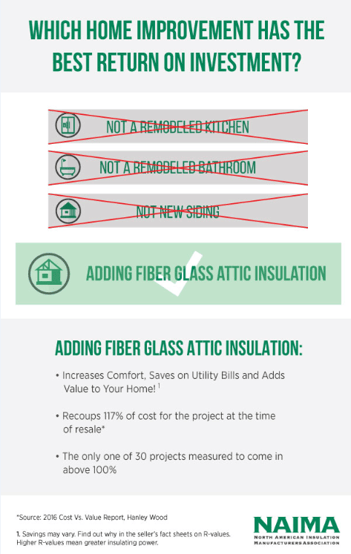New Research Proves Insulation Adds Value to a Home
 In the first 10 months of 2015, Americans spent $326 million on home remodeling projects. Thirty-eight percent of these projects included replacing dated surfaces, finishes and materials; 17 percent encompassed improving features and livability; and 13 percent of homeowners took on remodeling projects because it was just time for change.[1] While kitchen and bath remodels typically rank number one and two on the list of appealing home renovation projects, new research makes a persuasive case for undertaking a less sexy, higher return-on-investment upgrade: attic insulation. That’s right. The Tesla (kitchen or bath remodel) might be sexier and shinier, but it’s the Buick (insulation and air sealing) that’s going to deliver consumers the best bang-for-the-buck for home renovation dollar as well as improve home comfort and lower heating and cooling costs by as much as 30 percent.[2]
In the first 10 months of 2015, Americans spent $326 million on home remodeling projects. Thirty-eight percent of these projects included replacing dated surfaces, finishes and materials; 17 percent encompassed improving features and livability; and 13 percent of homeowners took on remodeling projects because it was just time for change.[1] While kitchen and bath remodels typically rank number one and two on the list of appealing home renovation projects, new research makes a persuasive case for undertaking a less sexy, higher return-on-investment upgrade: attic insulation. That’s right. The Tesla (kitchen or bath remodel) might be sexier and shinier, but it’s the Buick (insulation and air sealing) that’s going to deliver consumers the best bang-for-the-buck for home renovation dollar as well as improve home comfort and lower heating and cooling costs by as much as 30 percent.[2]
The first of two recent reports that affirm the benefits of an attic insulation upgrade was published in December by the National Association of Realtors and the National Association of the Remodeling Industry. The Remodeling Impact Report looked at the typical cost of 20 remodeling and replacement projects, assessed the appeal each project is likely to have for buyers, according to REALTORS® and estimated the cost that homeowners can recover on the cost of the project if they sold their home one year after the renovation. Of the 20 projects considered, insulation ranked third in cost recovery at 95 percent.
Additionally, last month, Hanley Wood released its annual Cost Versus Value Report, which for the first time, included a fiber glass attic insulation upgrade among the 30 potential remodeling projects considered. The report estimates the cost of a particular remodeling activity and real estate professionals assess the value that remodel will have to the home if it’s sold within one year of the completion of the project. The result: An attic insulation upgrade, which had an average estimated cost of $1,268 nationwide, delivered the highest return on the remodeling investment of $117 percent -- adding $1,484 to the value of the home if sold within one year.
“Finally seeing insulation in the mix as an established home improvement project really fills a gap,” said Laura Stukel, a REALTOR® with L.W. Reedy Real Estate in Elmhurst, IL. “Consumers have been investing in insulation upgrades for a long time and the ones that do are really happy with the work.”
How Happy? The Remodeling Impact Report includes a metric called the “joy score” a 10-point scale that assesses consumers’ satisfaction with the home renovations covered in the report. An insulation upgrade rated an 8.7 on a 10-point scale (by comparison, the kitchen upgrade joy score is 9.4). Not too shabby for something with no aesthetic appeal whose benefits are largely invisible
The Case for Comfort
A 2015 survey by the Demand Institute survey ranked energy efficiency as the number one unmet housing concern for consumers. At the same time, it can be a challenging issue to discuss with prospective home buyers and sellers. “Energy efficiency is a complicated thing because it’s in the walls and invisible to consumers, so real estate agents have been hesitant to touch it,” Stukel noted. “Recent reports of growing inventories of homes with advanced insulation are getting more attention in real estate, and appraisal studies are noting that homes like this can sell for 3 to 5 percent more than traditional homes, which has started to pique interest as well.”
Aside from the value that a fiber glass attic insulation upgrade adds to a home, there are other more immediate benefits to home owners who complete the project: improved comfort and lower home heating and cooling costs.
While historically some consumers and real estate agents may have overlooked a home’s energy efficiency, that’s clearly changing. “These studies are valuable because they help raise the visibility of projects like adding attic insulation, which has traditionally been thought of as a very unsexy project,” Stukel said. “But, the intangibles that you get — a more comfortable, less drafty home, are really compelling reasons for the overall consumer satisfaction with this project and these research results might encourage homeowners and homebuyers to invest in comfort, not just the aesthetics, of their homes.”
[1] Harvard University Tabulations of HUD Housing Surveys
[2] U.S. Department of Energy




